Safety and Health Management at Construction Sites
In the construction industry, the main contractor receives an order from a client, plans the entire process of the project, and considers construction methods. Then, specialist partner companies cooperate to complete the project based on the plan. As a main contractors, Kajima selects partner companies, organizes them into a hierarchical structure as needed, and drives the project forward.
Work to procure materials and machines and to select partner companies is vital for ensuring safety, health, and quality at construction sites while preserving the environment.
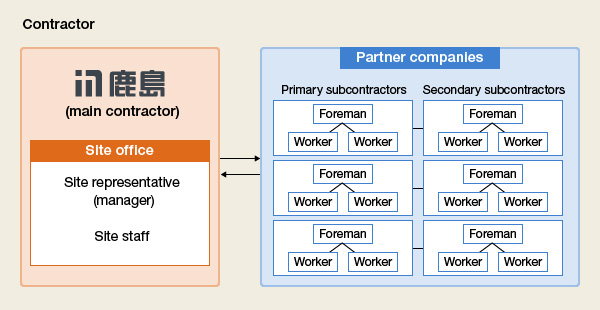
Relationship between Kajima and partner companies at construction sites
Workplace, Equipment, and Site Conditions
Kajima has defined Basic Safety Behavior to thoroughly implement its Safety and Health Policy and to ensure a safe working environment. Everyone works together in adhering to Basic Safety Behavior; not only employees, but also the CEOs and foremen of the partner companies that engage in the project.
By creating a safe working environment, we assure quality and keep to the schedule, and we can complete the construction work without accident, injury, or death. To remain faithful to the trust that customers and society placed in Kajima, we engage in efforts, build strong relationships of trust, and work on safety and health management alongside partner companies on a daily basis.
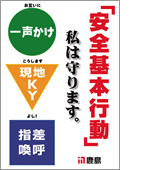
Poster to promote Basic Safety Behavior
Seeking to Eliminate Occupational Injuries, Deaths, and Accidents
Kajima smoothly launches and implements measures between the Head Office/branch offices and construction sites under a clear chain of command concerning safety and health.
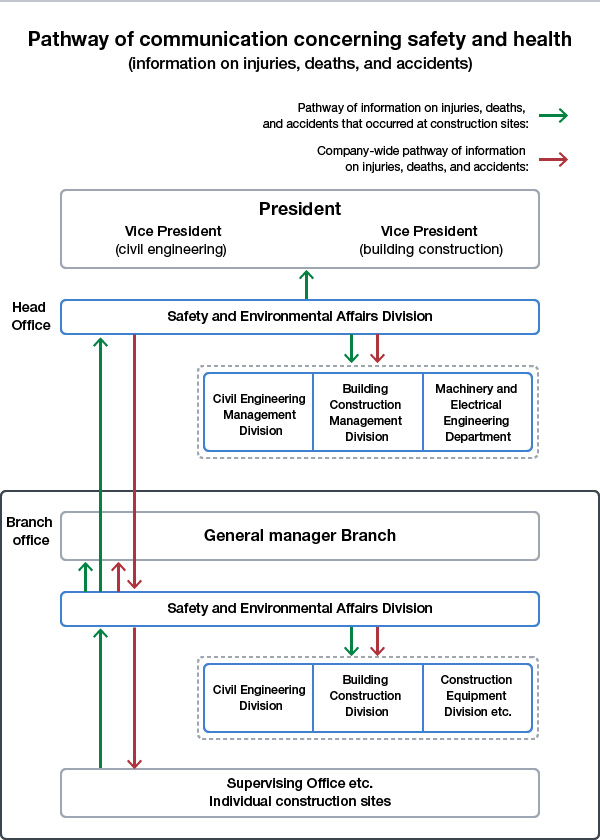
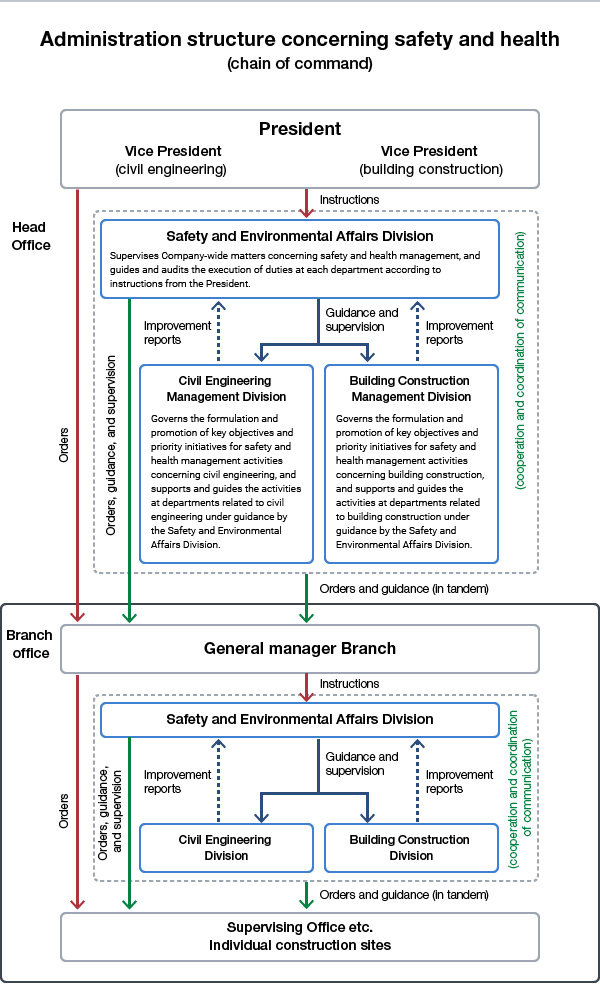
At the construction site, all construction details are reviewed with a safety-first policy. Then, medium- to long-term, weekly, and daily schedules are created based on the construction period, and daily tasks are carried out based on these schedules. Safety and health management at construction sites involves a close examination of how workers, heavy machines, and objects move in order to understand the situation, assure quality, and ensure an efficient and safer working environment.
Planning Construction Using Risk Assessment
Risk assessment is a method that involves identifying risks and hazards, and then estimating and assessing the potential for injuries, deaths, and accidents to occur before engaging in construction at every phase, including when planning construction and at the start of work.
After assessing potential dangers and hazards, it is crucial to implement a process of mitigating these risks, considering risk priorities, taking measures, and keeping records. Kajima pays particular care in conducting risk assessments when creating a construction plan, at a meeting of the construction preparation committee, and at a pre-construction review meeting on steel frame construction methods or other details following a review meeting held when a construction order is received. After construction begins, the Head Office and branch offices conduct risk assessments at all relevant construction sites through safety and health patrols and by other means. We improve the effectiveness of advance reviews with the help of the knowledge and experience of a large number of people, and even more people check construction sites with their own eyes, thereby further ensuring safety and health management.
Information Sharing and Preventive Activities
We offer multiple opportunities for thoroughly sharing information at the construction site. Each day starts with a morning meeting for announcing the day's work schedule and elements that require attention. The next day's tasks are discussed at a contact and work coordination meeting to coordinate tasks between specialist construction workers.
We also conduct visual inspections and checks using systematic procedures regarding the progress of work performed by Kajima employees and foremen from partner companies at construction sites, as well as checking for any instances of unsafe behavior or unsafe situations. If our staff notice an issue, they will approach relevant personnel as defined in the Kajima Basic Safety Behavior. We strive to ensure safety on a daily basis through steady activities based on the principles of workplace, equipment, and site conditions. Many staff members from the Head Office and branch offices also patrol construction sites to check them in person, thereby maintaining healthy tension and raising a sense of awareness for safety.
Representatives of Kajima employee associations have joined the Company-wide Safety and Health Committee, and employees and partner companies enhance the level of safety by establishing an accident prevention council at each construction site.
Responding to Emergencies
If an occupational injury, death, accident, or fire occurs, it is crucial to respond to it promptly in coordination with and while maintaining contact with relevant internal and external organizations. To this end, we share a contact list at each construction site when starting construction work.
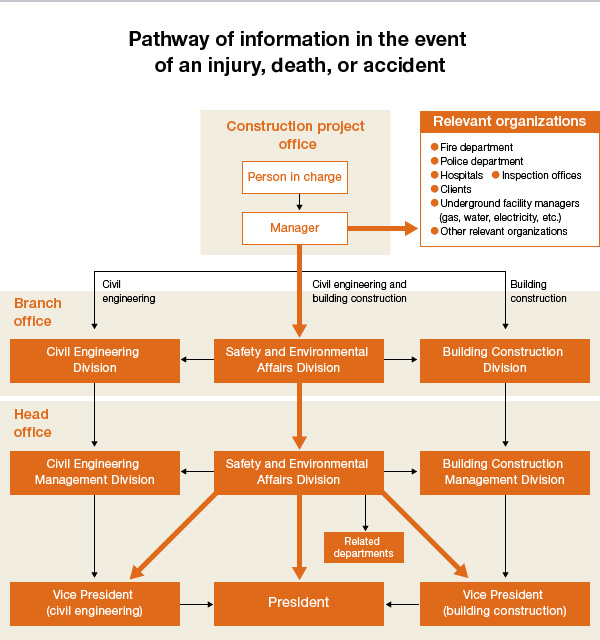
Safety Data
Planning and Implementing Recurrence Prevention Measures
In FY2012, we introduced a factor analysis method to prevent the recurrence of past cases of injuries, deaths, and accidents. In this method, we identify deviations from the procedures by sorting facts and events in chronological order. Next, we analyze factors from six different perspectives while reviewing the construction plan and other documentation and find out the necessary steps for preventing the incident. Based on this analysis, we develop and deploy measures to prevent identical or similar accidents from occurring and we introduce new rules across the company and branch offices if needed. We ensure that these preventive measures take root by confirming the status of implementation of these measures through patrols and by other means.
In FY2023, there were 159 occupational accidents that resulted in at least one day of lost work. Principal causes include falls (20 cases), getting caught in or between objects (33 cases), and flying or falling objects (9 cases). Based on the results of factor analysis, these cases are understood to have been caused by personnel falling into an opening in the floor or from a scaffold or mobile access platform, getting caught in or between heavy machines or materials, or by flying or falling objects during lifting operations. Measures for preventing these incidents include thoroughly covering openings, appropriately using of mobile access platforms, thoroughly restricting access to areas where workers may come into contact with heavy machinery, confirming the shape, weight, and route of a suspended load, and achieving clearance for paths when loads are moved (future preventive measures). The results of analysis for all occupational accidents were discussed in the Safety and Environmental Affairs Division and preventive measures were proposed and shared across the Group.
In FY2024, we aim to eliminate all deaths, severe injuries, serious incidents, and public disasters.
Ensuring Appropriate Labor Management
To eliminate the concealment of occupational incidents, Kajima strives to promote communication regularly such as by displaying posters to raise awareness at construction sites.
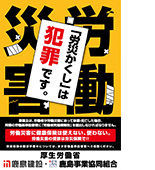
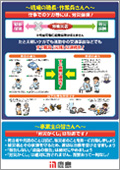
Posters to eliminate acts to conceal occupational accidents
Safety and Health Education, the Foundation for Eliminating Accidents
Corporate safety and health management is based on respect for human life and must be implemented thoroughly. With the evolution of construction technologies and with the structure of labor at construction sites growing more complicated, Kajima works to develop an education curriculum so that Kajima employees and the foremen and workers at partner companies can always implement safety and health management confidently.
Safety and Health Education for Employees
Kajima develops a curriculum so that employees can acquire the abilities to steadily implement safety and health management based on knowledge and experience while reviewing daily duties. Our three-level safety and health education program for employees consists of "basic training" featuring organized knowledge on laws, regulations, and bylaws, practical "administrator training" based on case studies,and "site manager training" that covers the ideal mindset to take for people engaged in management. These courses were taken by 420 employees in FY2019, 108 employees in FY2020, 131 employees in FY2021, 353 employees in FY2022, and 373 employees in FY2023.
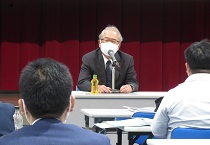
Lecture (site manager training)
by President Amano
- Basic training
It seeks to provide basic knowledge on laws, regulations, bylaws, and other relevant rules and boost risk sensitivity through hands-on training, thereby fostering the ability to implement disaster prevention measures at construction sites. - Administrator training
Raises safety and health awareness with a focus on case studies and cultivates administrative knowledge and capabilities. - Site manager training
Cultivates leadership skills for personnel who take the helm at construction sites, as well as risk management capabilities and overall judgment skills based on the understanding that the manager of the construction site is responsible for the activities on site.
Education Support for Partner Companies
The safety and health management education and training that we provide to partner companies includes "skill training" and "special training" that must both be conducted when assigning workers to duties that have a certain degree of risk or danger. We also offer "foreman/safety and health manager education" that must be taken by foremen who will be newly assigned to construction sites. These types of training are specified by the Industrial Safety and Health Act, and the duty to conduct these training programs is with the employers at partner companies. Even so, Kajima implements these training programs on behalf of these employers in order to support partner companies.
Furthermore, as the stable securing and assignment of outstanding foremen is important to maintain and improve Kajima's construction management standards, Kajima implements its own education program named "Foreman Capability Enhancement Training." Personnel who have completed this training program are certified as senior foremen upon approval from relevant department heads.
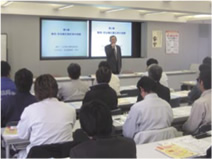
Foreman/Safety and Health Manager Training held at the Kyushu Branch
Strengthening Communication with Partner Companies
Partner companies are indispensable to Kajima. Kajima’s partner companies formed “Rokueikai”, whose primary purpose is engaging in activities to prevent accidents, as well as the “Kajima Business Partners’ Association”, which engages in various projects in the spirit of mutual aid. By joining partner companies in these organizations, Kajima makes it possible to ensure quality and safety together.
